While cows are undoubtedly iconic in the realm of livestock, the animal kingdom holds a rich tapestry of species that share intriguing similarities with these gentle bovines. From their herbivorous diets to their social dynamics and even physical features, there are various Animals Similar to Cows in surprising ways.
This article embarks on an enlightening exploration of animals that mirror cows in certain aspects, delving into the lesser-known corners of the animal world. Join us as we uncover the delightful diversity of herbivores that echo the bovine way of life, shedding light on the fascinating parallels that exist beyond the world of cattle.
Table of Contents
Description of Cows and Their Significance:
Cows, scientifically known as Bos taurus, are domesticated herbivorous mammals renowned for their economic, cultural, and nutritional significance. These gentle creatures are primarily known for their milk production, which is a vital source of dairy products globally. Moreover, cows play a critical role in sustainable agriculture, contributing to the fertilization of soils through their manure.
Culturally, they hold symbolic importance in various societies, often associated with agricultural practices, fertility, and traditional festivities. As a keystone species in modern agriculture, cows underscore the delicate balance between human reliance on animals similar to cows and the need for responsible and ethical husbandry.
Overview of Herbivorous Mammals Similar to Cows:
In the diverse tapestry of the animal kingdom, several herbivorous mammals share similarities with cows in terms of diet and habitat. These animals typically possess a digestive system adapted for processing plant-based diets, relying on an array of grasses, foliage, and sometimes grains.
Despite differing in size, appearance, and habitat, these herbivores echo the dietary habits and ecological roles of cows in various ecosystems. Understanding these animals sheds light on the broader adaptations and strategies herbivorous mammals employ to thrive in their respective environments.
Bison (Bison spp.):
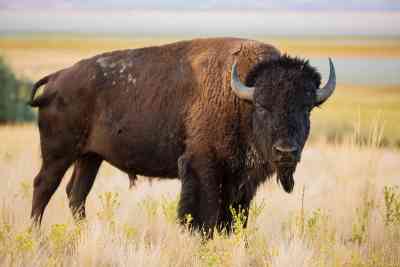
Bison, commonly known as American buffalo, are iconic large herbivorous mammals native to North America. They bear a striking resemblance to cows in terms of their cloven hooves, sturdy build, and herbivorous diet. Bison are characterized by their shaggy fur and impressive humpbacked shoulders, giving them a distinctive appearance. Historically, bison were essential to the indigenous peoples of North America, providing food, hides, and bones for various uses. While they may appear similar to domesticated cows, bison are wild animals and have adapted to survive in diverse ecosystems, ranging from grasslands to forests.
Buffalo (Syncerus caffer, Bubalus spp.):
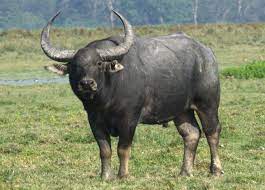
Buffaloes, whether the African buffalo or Asian water buffalo, are large, robust herbivores closely resembling cows in their general body structure. They possess a strong build, cloven hooves, and notable curved horns, traits they share with their bovine counterparts. Buffaloes are important domesticated animals, providing meat, milk, leather, and other valuable resources in many parts of the world.
The African buffalo, found in sub-Saharan Africa, is known for its unpredictable behavior and is considered one of the “Big Five” African safari animals, attracting wildlife enthusiasts from around the globe. The water buffalo, native to Asia, is widely utilized in agriculture and plays a significant role in the livelihoods of many communities.
Yak (Bos grunniens):
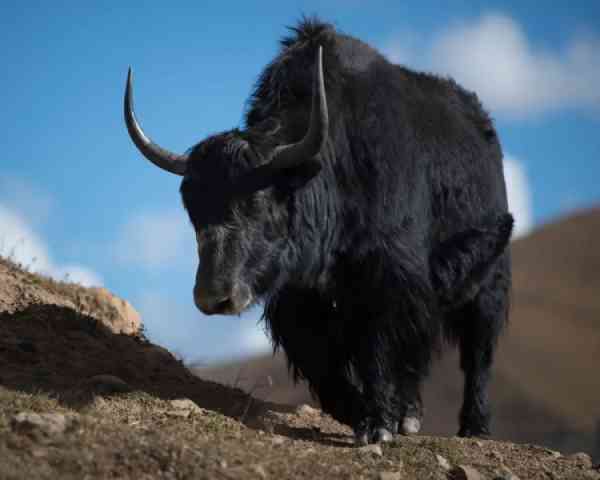
Yaks are hearty, domesticated bovids primarily found in the Himalayan region and Central Asia. These animals closely resemble cows but are adapted to survive in high-altitude, cold climates. Yaks possess a distinct hump on their shoulders, long, shaggy hair, and a thick coat to protect them from extreme weather conditions. They are essential to the livelihoods of many communities, providing milk, meat, wool, and transportation. The yak’s ability to thrive in harsh environments makes it a valuable asset for the people living in the rugged terrains of the Himalayas and surrounding areas.
Banteng (Bos javanicus):

Banteng, also known as tembadau, are wild cattle found in Southeast Asia, closely related to domesticated cattle. They have a strong resemblance to cows in terms of body structure and appearance.
Bantengs are characterized by their sturdy build, humped back, and distinctive coloration, which includes a dark brown coat with white markings. Despite being wild, they share many traits with their domesticated counterparts. Unfortunately, the population of banteng has been declining due to habitat loss and hunting.
Gaur (Bos gaurus):
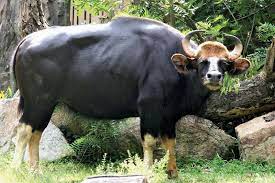
The gaur, also called the Indian bison, is a magnificent and robust wild cattle species native to South and Southeast Asia. Resembling a larger and more powerful version of domestic cattle, gaurs are the largest wild cattle species. They are characterized by a robust build, a distinctive hump on the back, and curved horns.
Gaurs are herbivores, primarily grazing on grasses and other vegetation. Their imposing size and majestic presence make them a significant attraction for wildlife enthusiasts and conservation efforts. Despite their powerful appearance, the gaur is listed as vulnerable due to habitat loss and poaching.
Zebu (Bos indicus):
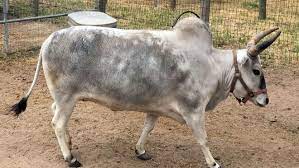
Zebu, often referred to as humped cattle, are a type of domestic cattle primarily found in South Asia, characterized by a distinctive hump on their shoulders. They share common ancestry with cows but are specially adapted to hot and arid climates. Zebus possess a hump that stores fat, providing them with a source of energy during droughts and scarce food periods. They are essential to agriculture, providing milk, meat, and leather in various parts of the world. Zebus are an integral part of the culture and economy of the regions they inhabit.
Muskox (Ovibos moschatus):

Muskoxen are fascinating herbivores inhabiting the Arctic regions of North America and Greenland. They resemble cattle with their sturdy build, cloven hooves, and shaggy fur adapted to withstand extreme cold. Muskoxen are known for their protective behavior, forming a defensive circle to guard against predators. Their wool, called qiviut, is highly prized for its warmth and softness. Despite their resemblance to cows, muskoxen have evolved to survive in one of the harshest environments on Earth.
Takin (Budorcas taxicolor):

Takin is a unique and robust goat-antelope found in the eastern Himalayas and parts of China. It possesses a combination of features resembling both cattle and goats, making it distinct and interesting. With a sturdy build, cloven hooves, and a thick coat, takins are well-adapted to the mountainous terrains they inhabit. They have a striking appearance, especially the males with their large, curved horns. Takins are herbivores and primarily feed on a variety of vegetation, showcasing their resemblance to cows in terms of dietary habits.
Anoa (Bubalus spp.):

Anoa, also known as midget buffalo, are small, forest-dwelling buffalo species native to Indonesia. They share similarities with domesticated cattle in terms of their body structure and appearance, particularly their cloven hooves and robust build. Despite their resemblance to cows, anoas are distinct and adapted to the dense, tropical forests where they reside. They are herbivorous and primarily feed on a variety of plants and vegetation found in their habitat.
Explanation of the Ruminant Digestive System and Its Characteristics:
The ruminant digestive system is a specialized and complex mechanism that allows certain animals, including cows, to efficiently break down cellulose-rich plant material. It consists of a four-chambered stomach, namely the rumen, reticulum, omasum, and abomasum, each with specific functions. This unique system enables a thorough fermentation process, breaking down tough plant fibers into digestible nutrients through microbial symbiosis. The ruminant digestive system is a marvel of adaptation, allowing these animals to derive maximal nutrition from plant matter, a characteristic essential for their herbivorous lifestyle.
Brief Overview of Various Cattle Breeds and Their Characteristics:
Cattle are a diverse group, encompassing numerous breeds worldwide, each with distinct characteristics suited to specific climates, purposes, and cultural contexts. From the massive and hardy Scottish Highland cattle to the high milk-yielding Holsteins, cattle breeds vary in size, color, adaptability, and productivity. Understanding the unique traits of these breeds is essential for efficient farming practices, ensuring that the right breed is selected based on factors like climate, geography, and intended agricultural outputs.
Similarities in Behavior and Social Structure:
While differing in specifics, various herbivorous mammals akin to cows exhibit comparable behavior and social structures. These include grazing patterns, herding tendencies, and communal behaviors that enhance their survival and reproductive success. Understanding these similarities provides insights into the evolutionary adaptations shared among herbivores, shedding light on how these animals navigate their ecological niches. From communication methods to hierarchical structures within groups, these behavioral parallels showcase the fascinating interconnectedness of the animal kingdom.
Final Words:
Exploring animals similar to cows opens a window into the intricate diversity and adaptations within the herbivorous realm. From their ecological roles to their significance in human culture and agriculture, these creatures illuminate the delicate balance between humanity and the animal kingdom. Recognizing and appreciating the similarities and differences among these animals enriches our understanding of biodiversity and emphasizes the need for responsible stewardship to ensure the sustainable coexistence of all species on our planet.
Reference:
- https://dictionary.cambridge.org/topics/mammals/cattle-and-similar-animals/
- https://www.mossy.earth/rewilding-knowledge/aurochs-rewilding
- http://bioweb.uwlax.edu/BIO203/s2014/hoefgen_laur/classification.htm#

Zahra Makda
Growing up enjoying the beauty of my village, a good passion for nature developed in me from childhood. Following my passion for the natural world, I have chosen zoology for my graduation, during my undergraduate degree, I participated in many nature trails, bird watching, rescues, training for wildlife conservation, workshop, and seminars on biodiversity. I have a keen interest in invertebrate biology, herpetology, and ornithology. Primary interests include studies on taxonomy, ecology, habitat and behavior.









